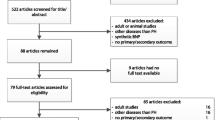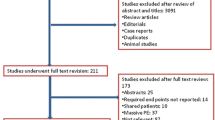Abstract
Background
Patients with pulmonary embolism (PE) have a high risk of death, and it is important to recognize factors associated with higher mortality. Recently, several biomarkers have been studied for risk stratification in patients with PE.
Objectives
Evaluate the available evidence on (a) the accuracy of brain natriuretic peptide (BNP) and N-terminal pro-brain natriuretic peptide (NT-proBNP) for the diagnosis of right ventricular dysfunction and (b) their value as a prognostic factor of all-cause in-hospital or short-term mortality in patients with PE.
Data sources
MEDLINE, Embase, and citation review of relevant primary and review articles.
Selection criteria
We selected studies evaluating the accuracy of BNP or NT-proBNP for the diagnosis of right ventricular dysfunction. We also selected studies that reported data on BNP or NT-proBNP as a predictor of short-term mortality in patients with PE.
Results
Sixteen studies met our inclusion criteria. The pooled diagnostic odds ratio for the diagnosis of right ventricular dysfunction in pulmonary embolism was 39.45 (95% CI; 15.54–100.12) and 24.73 (95% CI 2.02–302.37) for BNP and NT-proBNP, respectively. The pooled odds ratio for all-cause in-hospital or short-term mortality was 6 (95% CI 1.31–27.43; p: 0.021) and 16.12 (95% CI 3.1–83.68; p: 0.001) for BNP (cutoff: 100 pg/ml) and NT-proBNP (cutoff: 600 ng/L), respectively.
Conclusion
The results of this meta-analysis indicate that BNP and NT-proBNP are associated with the diagnosis of right ventricular dysfunction (RVD) in patients with an acute PE and are significant predictors of all-cause in-hospital or short-term mortality in these patients.





Similar content being viewed by others
References
Heit JA, Melton LJ 3rd, Lohse CM, Petterson TM, Silverstein MD, Mohr DN, O’Fallon WM (2001) Incidence of venous thromboembolism in hospitalized patients vs community residents. Mayo Clin Proc 76:1102–1110
Piazza G, Goldhaber SZ (2006) Acute pulmonary embolism: part I: epidemiology and diagnosis. Circulation 114:e28–e32
Goldhaber SZ, Visani L, De Rosa M (1999) Acute pulmonary embolism: clinical outcomes in the International Cooperative Pulmonary Embolism Registry (ICOPER). Lancet 353:1386–1389
Konstantinides S (2005) Pulmonary embolism: impact of right ventricular dysfunction. Curr Opin Cardiol 20:496–501
Kaczynska A, Pelsers MM, Bochowicz A, Kostrubiec M, Glatz JF, Pruszczyk P (2006) Plasma heart-type fatty acid binding protein is superior to troponin and myoglobin for rapid risk stratification in acute pulmonary embolism. Clin Chim Acta 371:117–123
Levin ER, Gardner DG, Samson WK (1998) Natriuretic peptides. N Engl J Med 339:321–328
Weber M, Hamm C (2006) Role of B-type natriuretic peptide (BNP) and NT-proBNP in clinical routine. Heart 92:843–849
Irwig L, Macaskill P, Glasziou P, Fahey M (1995) Meta-analytic methods for diagnostic test accuracy. J Clin Epidemiol 48:119–130
Walter SD (2002) Properties of the summary receiver operating characteristic (SROC) curve for diagnostic test data. Stat Med 21:1237–1256
Bossuyt PM, Reitsma JB, Bruns DE, Gatsonis CA, Glasziou PP, Irwig LM, Lijmer JG, Moher D, Rennie D, de Vet HC (2003) Towards complete and accurate reporting of studies of diagnostic accuracy: the STARD initiative. BMJ 326:41–44
von Elm E, Altman DG, Egger M, Pocock SJ, Gotzsche PC, Vandenbroucke JP (2007) Strengthening the reporting of observational studies in epidemiology (STROBE) statement: guidelines for reporting observational studies. BMJ 335:806–808
Zamora J, Abraira V, Muriel A, Khan K, Coomarasamy A (2006) Meta-DiSc: a software for meta-analysis of test accuracy data. BMC Med Res Methodol 6:31
DerSimonian R, Laird N (1986) Meta-analysis in clinical trials. Control Clin Trials 7:177–188
Egger M, Smith GD, Altman DG (2001) Systematic reviews in health care, 2nd edn. BMJ, London
Morgan M, Kalantri S, Flores L, Pai M (2005) A commercial line probe assay for the rapid detection of rifampicin resistance in Mycobacterium tuberculosis: a systematic review and meta-analysis. BMC Infect Dis 5:62
Moses LE, Shapiro D, Littenberg B (1993) Combining independent studies of a diagnostic test into a summary ROC curve: data-analytic approaches and some additional considerations. Stat Med 12:1293–1316
Mantel N, Haenszel W (1959) Statistical aspects of the analysis of data from retrospective studies of disease. J Natl Cancer Inst 22:719–748
Lee SJ, Lee JH, Park JY, Jo WS, Kim JE, Kim KU, Park HK, Kim YS, Lee MK, Park SK (2006) The prognostic role of B-type natriuretic peptide in acute pulmonary thromboembolism. Tuberc Respir Dis 60:540–547
Yetkin O, Aksoy Y, Turhan H, In E, Karahan M, Kilic T, Hacievliyagil SS, Gunen H (2007) Value of plasma BNP levels as a prognostic marker in lung and heart disorders. Tuberk Toraks 55:225–230
Kaczynska A, Pelsers MM, Bochowicz A, Kostrubiec M, Glatz JF, Pruszczyk P (2006) Plasma heart-type fatty acid binding protein is superior to troponin and myoglobin for rapid risk stratification in acute pulmonary embolism. Clin Chim Acta 371:117–123
Kucher N, Walpoth N, Wustmann K, Noveanu M, Gertsch M (2003) QR in V1—an ECG sign associated with right ventricular strain and adverse clinical outcome in pulmonary embolism. Eur Heart J 24:1113–1119
Enea I, Ceparano G, Mazzarella G, Di Sarno R, Cangiano G, Busino CA (2004) Biohumoral markers and right ventricular dysfunction in acute pulmonary embolism: the answer to thrombolytic therapy. Ital Heart J 5(1 Suppl):29–35
Sohne M, Ten Wolde M, Boomsma F, Reitsma JB, Douketis JD, Buller HR (2006) Brain natriuretic peptide in hemodynamically stable acute pulmonary embolism. J Thromb Haemost 4:552–556
Pascu AM, Radoi M, Coculescu M (2005) Plasma brain natriuretic peptide (BNP) increase is associated with acute right ventricular dysfunction in pulmonary embolism. Acta Endocrinol 1:393–410
Kiely DG, Kennedy NS, Pirzada O, Batchelor SA, Struthers AD, Lipworth BJ (2005) Elevated levels of natriuretic peptides in patients with pulmonary thromboembolism. Respir Med 99:1286–1291
Kucher N, Printzen G, Goldhaber SZ (2003) Prognostic role of brain natriuretic peptide in acute pulmonary embolism. Circulation 107:2545–2547
Ray P, Maziere F, Medimagh S, Lefort Y, Arthaud M, Duguet A, Teixeira A, Riou B (2006) Evaluation of B-type natriuretic peptide to predict complicated pulmonary embolism in patients aged 65 years and older: brief report. Am J Emerg Med 24:603–607
Ten Wolde M, Tulevski II, Mulder JWM, Sohne M, Boomsma F, Mulder BJM, Buller HR (2003) Brain natriuretic peptide as a predictor of adverse outcome in patients with pulmonary embolism. Circulation 107:2082–2084
Tulevski II, Ten Wolde M, van Veldhuisen DJ, Mulder JW, van der Wall EE, Buller HR, Mulder BJ (2007) Combined utility of brain natriuretic peptide and cardiac troponin T may improve rapid triage and risk stratification in normotensive patients with pulmonary embolism. Int J Cardiol 116:161–166
Kruger S, Graf J, Merx MW, Koch KC, Kunz D, Hanrath P, Janssens U (2004) Brain natriuretic peptide predicts right heart failure in patients with acute pulmonary embolism. Am Heart J 147:60–65
Logeart D, Lecuyer L, Thabut G, Tabet JY, Tartiere JM, Chavelas C, Bonnin F, Stievenart JL, Solal AC (2007) Biomarker-based strategy for screening right ventricular dysfunction in patients with non-massive pulmonary embolism. Intensive Care Med 33:286–292
Pieralli F, Olivotto I, Vanni S, Conti A, Camaiti A, Targioni G, Grifoni S, Berni G (2006) Usefulness of bedside testing for brain natriuretic peptide to identify right ventricular dysfunction and outcome in normotensive patients with acute pulmonary embolism. Am J Cardiol 97:1386–1390
Binder L, Pieske B, Olschewski M, Geibel A, Klostermann B, Reiner C, Konstantinides S (2005) N-terminal pro-brain natriuretic peptide or troponin testing followed by echocardiography for risk stratification of acute pulmonary embolism. Circulation 112:1573–1579
Kostrubiec M, Pruszczyk P, Kaczynska A, Kucher N (2007) Persistent NT-proBNP elevation in acute pulmonary embolism predicts early death. Clin Chim Acta 382:124–128
Kostrubiec M, Pruszczyk P, Bochowicz A, Pacho R, Szulc M, Kaczynska A, Styczynski G, Kuch-Wocial A, Abramczyk P, Bartoszewicz Z, Berent H, Kuczynska K (2005) Biomarker-based risk assessment model in acute pulmonary embolism. Eur Heart J 26:2166–2172
Puls M, Dellas C, Lankeit M, Olschewski M, Binder L, Geibel A, Reiner C, Schafer K, Hasenfuss G, Konstantinides S (2007) Heart-type fatty acid-binding protein permits early risk stratification of pulmonary embolism. Eur Heart J 28:224–229
Kucher N, Printzen G, Doernhoefer T, Windecker S, Meier B, Hess OM (2003) Low pro-brain natriuretic peptide levels predict benign clinical outcome in acute pulmonary embolism. Circulation 107:1576–1578
Pruszczyk P, Kostrubiec M, Bochowicz A, Styczynski G, Szulc M, Kurzyna M, Fijalkoska A, Kuch-Wocial A, Chlewicka I, Torbicki A (2003) N-terminal pro-brain natriuretic peptide in patients with acute pulmonary embolism. Eur Respir J 22:649–653
Vuilleumier N, Righini M, Perrier A, Rosset A, Turck N, Sanchez JC, Bounameaux H, Le Gal G, Mensi N, Hochstrasser D (2007) Correlation between cardiac biomarkers and right ventricular enlargement on chest CT in non massive pulmonary embolism. Thromb Res 121:617–624
Wood KE (2002) Major pulmonary embolism: review of a pathophysiologic approach to the golden hour of hemodynamically significant pulmonary embolism. Chest 121:877–905
Goldhaber SZ (2004) Pulmonary embolism. Lancet 363:1295–1305
Tulevski II, Mulder BJ, van Veldhuisen DJ (2002) Utility of a BNP as a marker for RV dysfunction in acute pulmonary embolism. J Am Coll Cardiol 39:2080
Ribeiro A, Lindmarker P, Juhlin-Dannfelt A, Johnsson H, Jorfeldt L (1997) Echocardiography Doppler in pulmonary embolism: right ventricular dysfunction as a predictor of mortality rate. Am Heart J 134:479–487
Kucher N, Rossi E, De Rosa M, Goldhaber SZ (2005) Prognostic role of echocardiography among patients with acute pulmonary embolism and a systolic arterial pressure of 90 mm hg or higher. Arch Intern Med 165:1777–1781
Vieillard-Baron A, Page B, Augarde R, Prin S, Qanadli S, Beauchet A, Dubourg O, Jardin F (2001) Acute cor pulmonale in massive pulmonary embolism: incidence, echocardiographic pattern, clinical implications and recovery rate. Intensive Care Med 27:1481–1486
Becattini C, Vedovati MC, Agnelli G (2007) Prognostic value of troponins in acute pulmonary embolism: a meta-analysis. Circulation 116:427–433
Goldhaber SZ (2008) Assessing the prognosis of acute pulmonary embolism: tricks of the trade. Chest 133:334–336
Storch J, Thumser AE (2000) The fatty acid transport function of fatty acid-binding proteins. Biochim Biophys Acta 1486:28–44
Goetze JP, Gore A, Moller CH, Steinbruchel DA, Rehfeld JF, Nielsen LB (2004) Acute myocardial hypoxia increases BNP gene expression. FASEB J 18:1928–1930
Sohne M, Ten Wolde M, Buller HR (2004) Biomarkers in pulmonary embolism. Curr Opin Cardiol 19:558–562
Acknowledgments
We thank Drs. David G. Kiely and Filippo Pieralli for providing additional information on their respective studies.
Author information
Authors and Affiliations
Corresponding author
Rights and permissions
About this article
Cite this article
Cavallazzi, R., Nair, A., Vasu, T. et al. Natriuretic peptides in acute pulmonary embolism: a systematic review. Intensive Care Med 34, 2147–2156 (2008). https://doi.org/10.1007/s00134-008-1214-5
Received:
Accepted:
Published:
Issue Date:
DOI: https://doi.org/10.1007/s00134-008-1214-5




